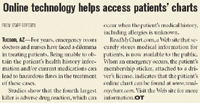Article
Prompt intervention needed with stroke patient
Atlanta—It is important to recognize and intervene promptly in patients who may have symptoms of an impending stroke, according to Nancy Newman, MD, who is professor of ophthalmology and neurology, Emory University School of Medicine, Atlanta.

"In some cases, the only medical doctor that a patient may be seeing on a regular basis is an ophthalmologist," noted Dr. Newman, who advised ophthalmologists on the best treatment for ischemic infarction.
The term "cerebral infarction" is an umbrella phrase for many different types of stroke, she noted. "The treatment, therefore, is guided by the type of stroke in each patient, and it is divided into either acute intervention or secondary prevention."

"Most of all, do no harm. The best thing you can do for these patients is admit them to a stroke unit where a stroke neurologist and intensive care personnel will prevent immediate complications [such as metabolic disturbances] and long-term complications, begin secondary prevention of another stroke, and plan rehabilitation," she emphasized.
The FDA has approved only one treatment for acute cerebral stroke, intravenous tissue plasminogen activator (tPA). The drug increases the chances of good recovery by 30% to 50%, however, the treatment window is very small-only 3 hours from the onset of symptoms. In addition, there are very strict guidelines concerning which patients are candidates for treatment with tPA, according to Dr. Newman. The main adverse event associated with tPA is symptomatic hemorrhage, which usually develops in the region of the brain where the stroke occurred.
Dr. Newman also explained that intra-arterial thrombolysis might be performed at institutions where interventional neurologists are trained to snake a catheter to where the clot rests in the artery and administer an agent that will dissolve the clot. There is a higher hemorrhage rate associated with this procedure, but the window of opportunity for its use is 6 hours.
"Other acute treatments are not as dramatic," she explained.
"For those patients who have not had a big stroke and who have a high risk of subsequent embolic strokes, such as patients with atrial fibrillation and large clots in the left ventricle, acute anticoagulation can be used," Dr. Newman said. "Acute aspirin therapy is very benign and may help some patients."
However, when all factors are considered, such as which patients are likely to benefit from which therapy given the limited time frames in which some therapies can be administered, the best course an ophthalmologist can take is to admit the patient to a stroke unit, Dr. Newman advised.
Secondary prevention is an arena in which ophthalmologists can be more involved with patients who have had a stroke.
Dr. Newman pointed out that there are stroke risk factors that need to be addressed in every patient who has an ocular or a hemispheric stroke. Several of these risk factors are modifiable, especially hypertension, hyperlipidemia, cigarette smoking, obesity, and physical inactivity.
"The greatest thing an ophthalmologist can do to help a patient who has already had a stroke to avoid another one is to reduce the patient's blood pressure. Several large studies have shown that a reduction by 10 mm Hg in systolic blood pressure converts to a one-third reduction in the risk of stroke in certain age groups. The reduction in the risk of stroke continues down to 115/75 mm Hg. Lowering the blood pressure of a patient who has had a stroke from 120/80 mm Hg by 10 mm Hg also reduces the risk of stroke in that patient by one-third," she said.
Newsletter
Don’t miss out—get Ophthalmology Times updates on the latest clinical advancements and expert interviews, straight to your inbox.




